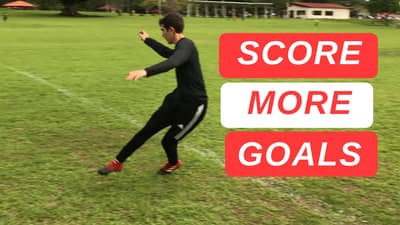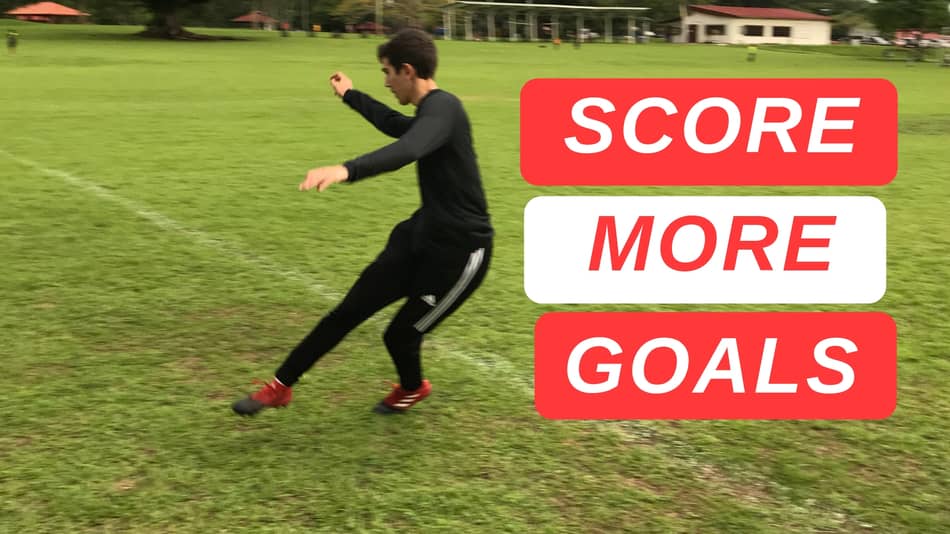
Some years ago, when I was a teenager, I got to be a ball boy at a friendly “David Villa”, famous Spanish and Barcelona striker, was playing at. Of course, Villa is a supreme scoring machine, so I tried to learn as much as I could watching him play from so close in that match. If you want to learn to score more goals, I’ll teach you everything that David and most succesful players do to be ultimate goalscorers.
So, how do you score more goals in soccer? Summarized, to be a great goalscorer you don’t necessarily have to be the most skilled player in the soccer field. Most goalscorers are players that are effective and know how to benefit from the few opportunities they have to score, are good at improvisation, master composure, and are very intelligent with the ball.
This are just few of the characteristics a soccer player should have in order to score a lot of goals. Most people who score few goals are not bad at all, they simply don’t know the fundamental aspects to drastically improve their accuracy and become a deadly scoring machine. With that said, make sure you implement the tips in this article to your game, and you’ll see that scoring opportunities will come more often.
Scoring more goals
We all love scoring goals, and the feeling and joy it brings to celebrate them. We feel like we are on top of the world, that we are the heroes. In my article “Why soccer is the most popular sport” I explain how this aspect of the game, contributes to making this sport so popular.
Any player in the field can score a goal (strikers, defenders, midfielders, and even goalkeepers), but the truth is that not all of them should be focused on scoring as many goals as possible. I know it feels good, but unless you’re not a striker, your main job in the field is not to score goals, and maybe if you focus too much in this aspect you’ll forget about your true purpose in the team.
With that said, scoring goals is beneficial for both the player and the team, and no matter your position, if you score goals it will bring positive results to everyone. Which is why the following tips will work for any player. I have put them together in this bulleted list so you can take a look at them, and we’ll review each one more in detail later.
Tips to score more goals:
- #1 Make low shots
- #2 Using both feet
- #3 Few touches, great accuracy
- #4 Effectiveness
- #5 The far post
- #6 Composure tips
- #7 Improvisation is everything
- #8 Try luck shooting sometimes
- #9 Being in the right place, at the right time
- # 10 Balance between power and precision
- #11 Peripheral vision
- #12 Use your own strengths
- # 13 Tips for midfielders and defenders
#1 Making low shots
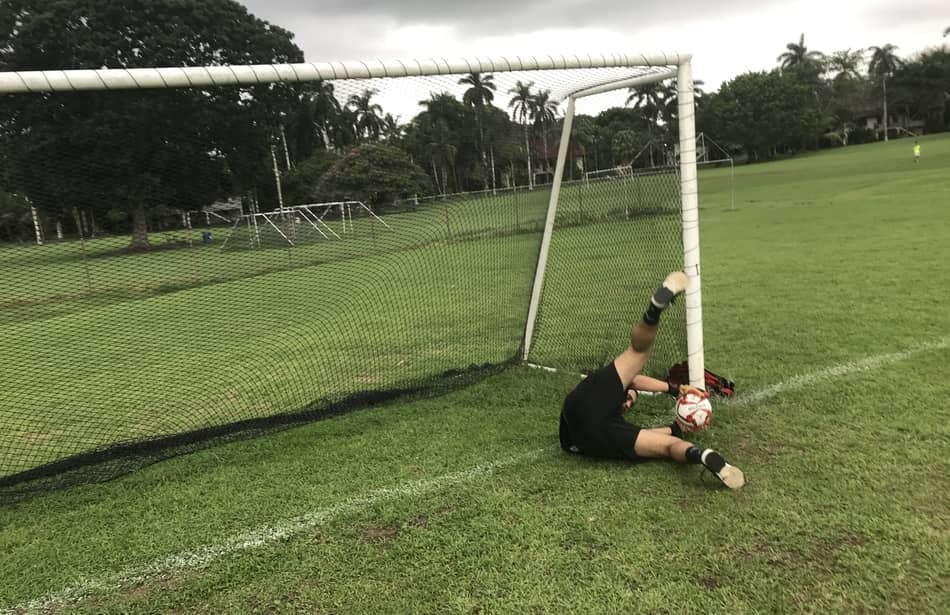
Low shots are extremely hard to stop for goalkeepers. When you shoot low, you force the goalkeeper to dive and stretch for the ball, which obviously takes more time for him to get to the ball. A precise and powerful low shot to the sides of the goal is almost unstoppable for the goalkeeper.
#2 Using Both feet
A great goalscorer needs to be able to use both feet near perfection. If you are only able to shoot with one foot, it will be very easy for a defender to defend against you because it is very predictable to which side you are going to play. In the other hand, if you are able to use both feet, you are a bigger threat because you can shoot and play to either side causing danger.
When you are able to use both feet, it’s like you have more weapons and tools to play with, and more tools means more options. Sometimes, you won’t have the chance to position yourself in the best way possible to shoot with your strong foot, but if you are able to use both you have more options on things you can do to score.
A great example is Cristiano Ronaldo, He is able to score goals with both feet near perfection, which is something that has made him one of the best players ever. Ronaldo’s ability to use both feet gives him more options, buys him time inside the box, and makes him and unpredictable player.
#3 Few touches, great accuracy
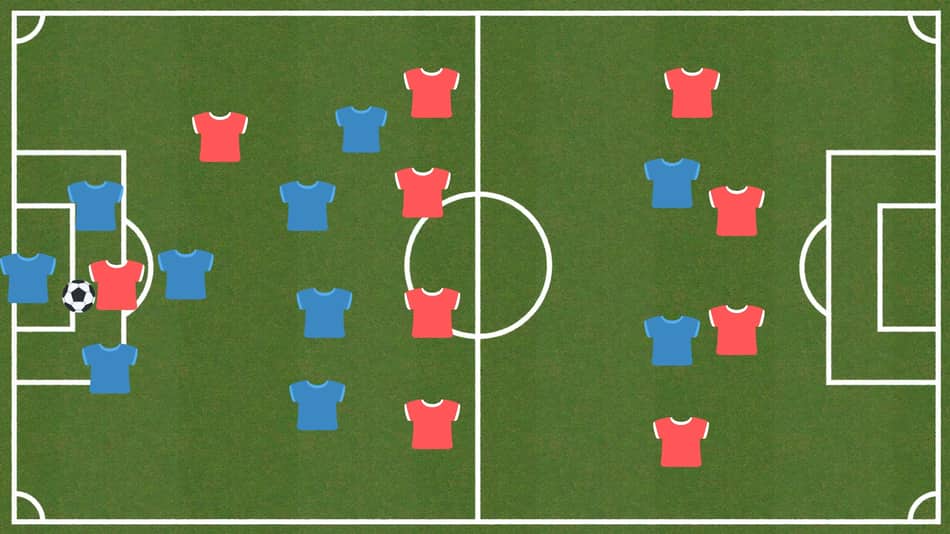
When you are in the box you need to be an “economic” player. What I mean by economic is that you have to make as few touches as possible to obtain the best results possible. In the box, time is limited and sometimes you won’t have time to think and make that many touches. To score a lot of goals, you need to position yourself to make a shot with as little as one touch.
As you can see in the picture, the player that has the ball in the box has few time to make a shot because he is surrounded by 4 players. In the box, you have to keep it simple, make the fewest touches possible and make a strong and accurate. The fewer touches, the less time you give the defenders to react.
#4 Effectiveness
The best scorers in the history of this game are not the ones that had the most opportunities to score goals, the best are the ones that convert the few chances they had to score. I’d rather have a player in my team that has one chance to score and makes it, than one that fails to score 10 opportunities he had during the game.
Specially if you’re a striker, you’ll have to sacrifice a little in defense and game creation. It doesn’t matter if you don’t touch the ball one single time during the whole game. The only thing that matters is that when the chance to score comes, you put the ball in the net.
Effectiveness is not only what makes a great goalscorers, but also what makes great teams. How many times have we seen teams that missed many chances during a game and ended up loosing when the other team scored the one chance they had? When this happens we say it’s unfair but it isn’t, because in soccer wins effectiveness over anything else.
#5 The far post

When you are going to finish, always make sure to shoot for the far post as you see in the picture. The reason is simple, it is more humiliating for a goalkeeper to be scored a goal on his own post than in the far post, which is why they’ll usually cover a lot more their own post. Also, in case the goalkeeper gets to stop the shot there are greater chances that the ball stays in play, and your teammates might end up scoring even after you missed.
#6 Composure tips
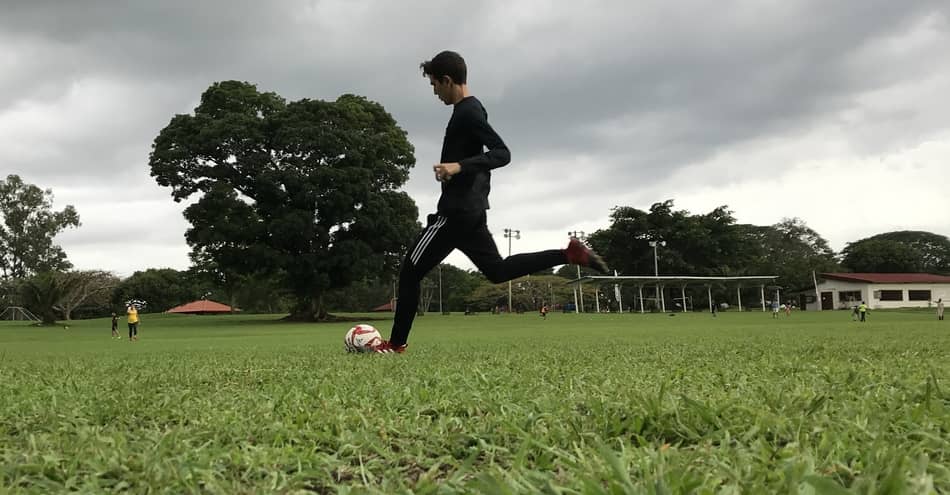
One thing that makes a great goalscorer is the composure they have at the moment of finishing. Composure is basically they state of calm and being in control of ourselves. Nerves are your biggest enemy every time you’re about to score a goal, shoot outside the box or kick a penalty. The players that score the most are mostly “cold blooded” beasts. There are two tips I can give you to help you develop your composure:
Control the controllables: One of the things that makes us go nuts is trying to change something that can’t be changed. What are factors that we can’t control in a soccer game? The referee’s decisions, an aggressive player from the other team, the weather and playing conditions of the field, etc. What are factors we can control? Our playing performance, how we shoot, teamwork, passing precision, etc.
If we focus on only controlling the controllable factors, our levels of composure overall will rise significantly. Simply by accepting the fact that the non-controllable factors are things we will never be able to change no matter how much we try, you’ll see increased levels of calm. Which will be beneficial in helping you score more goals.
Second is taking accountability for your acts. When you miss a goal scoring opportunity you can react in two ways: You can either blame the playing conditions of the pitch, the referee, and make 100o excuses, or you can take accountability of your mistake to move on and score in the next opportunity. Once you start being honest with yourself and accept the things you are doing wrong, composure rises significantly.
#7 Improvisation is everything
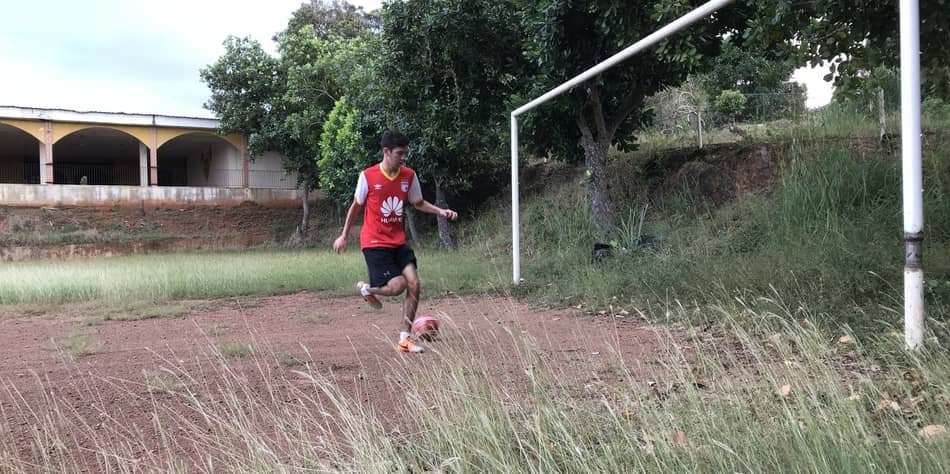
Most of the times you have an opportunity to score a goal, the ball won’t be perfectly positioned for you to kick it. You need to be ready to improvise and score the goal no matter how the ball is coming at you. For example, a player crosses you the ball but the cross was to low, you then improvise and, instead of heading the ball, you hit it with the shoulder or chest to score. Maybe the cross was too far behind so you made a back heel to score.
Soccer is a game that is not only played with your feet, but also with your mind. Be intelligent at the most important moments, improvise and be creative. You have to demonstrate that you have multiple resources to score however, wherever, and whenever you want. Developing your deadly goalscoring instinct will be fundamental to score more goals.
#8 Try luck shooting sometimes
You don’t necessarily have to get to the goal in order to shoot. Sometimes, it is a good idea to try luck shooting from outside and see what happens. You have no idea how many times players have scored in this way. There is a famous saying that goes like this: “If you don’t shoot, you don’t win”. If the game is tight and the defense is standing strong, try shooting from outside the box and who knows what can happen, maybe there is a deflection from a defender or the goalkeeper makes a mistake. Try your luck once in a while
#9 Being in the right place, at the right time
The best goalscorers know where they have to be and when they have to be there. That is what I called the goalscoring instinct or smell. We’ve seen multiple times what we call “rebound goals”. The goalkeeper stops the ball, and the rebound ends up for another player that finally scores the goal easily. Or maybe the ball hits the post or is deflected and magically ends up in the striker’s feet.
Well, this is not magic, he knows there is exactly where he has to be at the right time. A correct positioning in the field will give you a huge advantage at the time of scoring. If you know where should be and when you should be there, scoring goals will be relatively easy and a matter of just pushing the ball to the net. The goalscoring smell is something you can only develop through experience.
#10 Balance between power and precision
In order to score more goals, you must know when is the right time to use power and when you should use precision. Normally, a middle point the combines both will be lethal for any goalkeeper. If you shoot with too much power, your shots are going to be considerably less precise and might not even be directed to the goal. In the other hand, if you aim to be too precise, the shot will be too slow and easy to stop for the goalkeeper.
#11 Peripheral vision
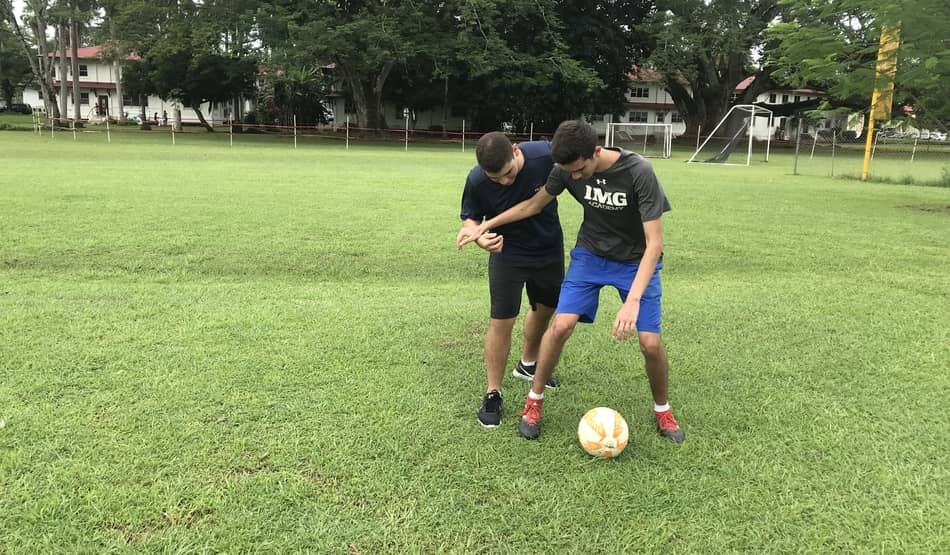
Peripheral vision is what is seen on the eyes by the side when you’re looking straight ahead. It is extremely important to have a great peripheral vision because you constantly need to be watching by the side where the goalkeeper is positioned, where the defenders are, at the same time you are looking at the ball.
Before finishing, you have to always use your peripheral vision to see where the goalkeeper is positioned, and depending on where he is, you make the shot. Sometimes, the goalkeeper might be outside the goal, so it would be a good idea to make a chip in this case. Other times he’ll be closer to his near post, so you should shoot to the far post. It is also useful when you receive the ball and need to know where the defenders are to make your first touch accordingly.
What is great is that vision training is something that actually exists. You can literally train your vision to be faster and have an improved peripheral view. At camp, they put us in front of a screen with red leds, and each time one of them turned on, we would had to touch it as fast as possible. They also showed us an app called “Kinetic Visual Acuity” you can download in the app store to train your vision while lying on bed.
#12 Using your own strengths
We all have different attributes that makes us unique. The way I score goals is different from the way other people score goals. There people that are very tall, and others that are shorter players but faster. You have to learn how to use your own strengths to your advantage to score the most goals possible.
If you’re tall for example, it would be a good idea to try to score as many goals with your head as you can. You should avoid dribbling too much, instead, pass the ball to the wingers and wait for a great cross to head. A great example is Belgium’s Maroune Fellaini. I’ve never seen him dribbling or making crosses, but many times he has saved his team by scoring a goal with his head thanks to his height.
If you are a shorter player but faster, then you should change your playing style. Try avoiding the air game and beat your opponents using purely your speed. Make combinations with other players and get as close to the goal as possible to shoot. One great example is Lionel Messi, he is probably the shortest guy in his team, but he can surely score a lot of goals.
By the way, I wrote an article about the Best Soccer Positions for Short players. If your a short guy it might be useful for you.
The way Messi scores his goals is different from how Cristiano Ronaldo scores. That is because they have both learned how to use their own strengths, adapting their playing style to the game. You must do the same, think on what are your greatest attributes and create a playing style according to them.
#13 Tips for midfielders and defenders
As I said at the beginning, if you’re not a striker you should remember that your priority is not to score. Midfielders should focus in creating game and recovering the ball, and defenders must defend. However, that doesn’t mean they can’t score goals at all. We’ve seen great scoring midfielders and defenders during the years. Here are a couple of tips for each one.
More goals as a midfielder
If you’re a midfielder, I would say that the best way to score more goals is to start shooting more from outside the box. Normally, great midfielders have a great shooting technique, which is why it’s very common to see them scoring from this distance. Also, it offers an alternative when the defense is standing strong to create danger. If the goalkeeper gets to stop the shot, there are great chances the ball will still be in play, increasing the chances of the team to score.
Another great way is by moving to the space when making crosses. In the image below, you can see what I am trying to explain. The winger carries the ball and is about to make a cross to the box were all the defenders and attackers are. The midfielder moves to the space and the winger makes a cross backwards to where the midfielder is, so he now has an open shot opportunity. This is a very common play to see in big clubs like Real Madrid and Barcelona.

More goals as a defender
In an interview to Sergio Ramos, he was asked to give some tips for defenders that wanted to score more goals as he did. He said: “You should always remember that your main purpose is to defend your goal. Scoring goals shouldn’t be a priority for you. If you have the chance to score, then great, but always focus on defending your own goal first.
He is totally right, but he didn’t give us the answer we were waiting. I decided to analyze some of the aspects that make a goalscoring defender. First of all you need to know when are the ideal game situations when a defender should go to the attack to score a goal.
- Corner kicks: Defenders are usually the tallest guys in the team, which is why it is very common that they go to head the ball at corner kicks. Just make sure to have a teammate (maybe an attacker or midfielder) that covers your position.
- For late comebacks: If your team is losing the game and desperately needs a comeback for the win, then defenders are totally allowed to attack to get the late winner. When this happens, usually even goalkeepers move forward for the goal. At this point it’s the same to lose by one or two goals.
- Freekicks: Some teams like preparing tactical plays to score on freekicks that include the defenders presence.
As you can see, central defenders usually use their best attributes which are height and strength to score. For this reason, if you want to be a complete defender, it is important that you master your heading technique.
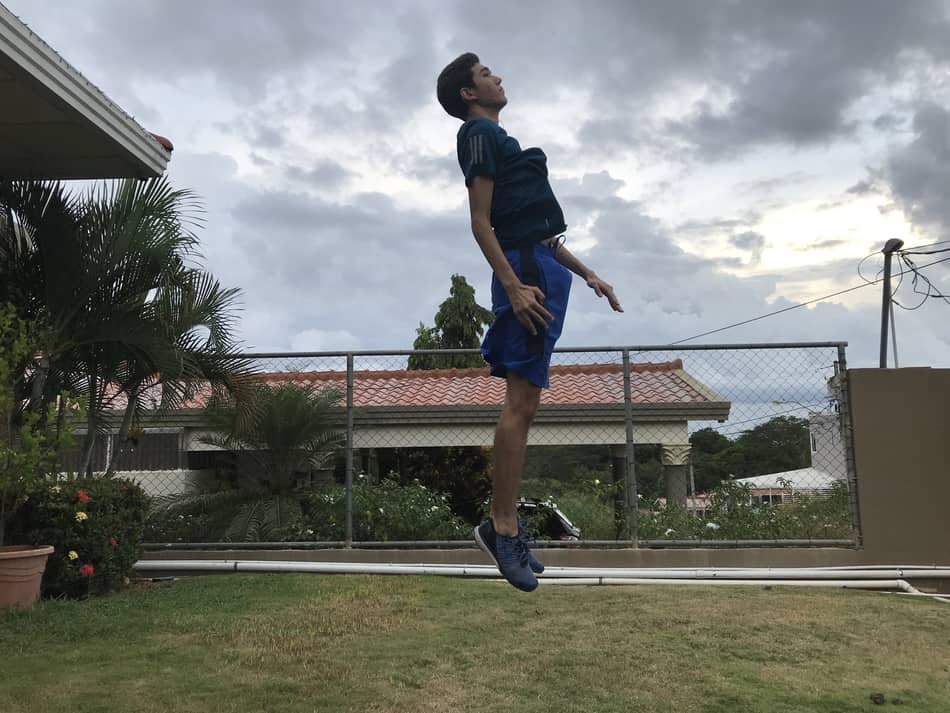
In the other hand, if you’re a short height full-back, then you can absolutely score in other ways. Take as an example Marcelo and Dani Carvajal at Real Madrid. They score goals by making combinations of passes with their teammates until they reach the goal. Again, make sure you use your strengths to adapt your playing style to the game.
Make sure to check out my article “How to be a Better Soccer Defender” so you get all the tips to master your defending technique and be the most complete defender you can be.
Drills to practice
Shooting to the sides
A great drill alike to practice is the one you can see in the picture. You can use two objects of your preference and you put them about two feet away from each post. The idea is that you finish scoring between the object and the post. This drill is great to practice precision and improving your finishing skills. The closer you position the objects to the post the harder it will be, but the better you’ll train your precision.
There are a lot of variation you can do. You can have someone make crosses, and you have to finish scoring in the area. You can also have someone make passes to you and you have to quickly position yourself with the fewest touches possible to finish scoring between the post and the object and the post. The possibilities are endless, get creative with this exercise.

Two touches: Turn and shoot
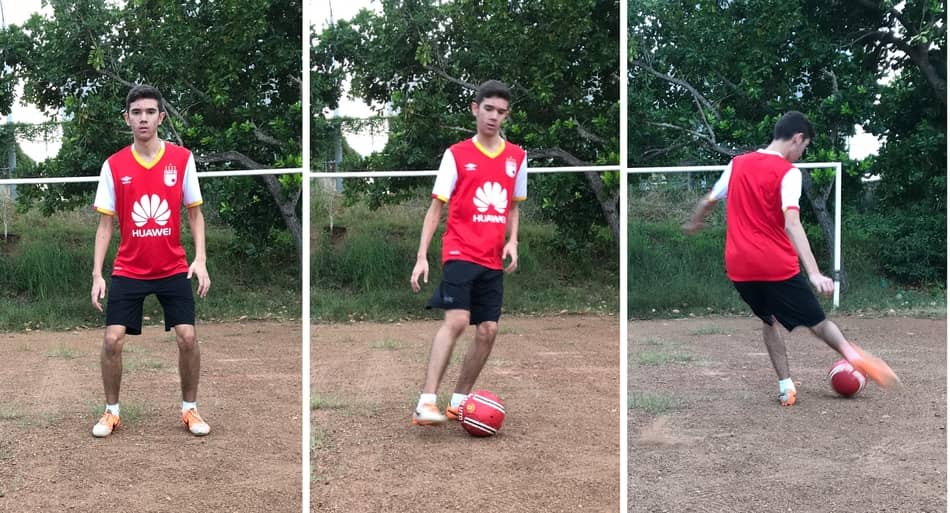
This is one I like a lot and that you can perfectly combine with the previous drill and a goalkeeper. You position backwards from the goal. Have someone pass you the ball (or pass it to yourself by making it bounce to a wall), and with only two touches you have to turn and shoot to the goal. To make it more difficult you can add the objects from the previous exercise, a goalkeeper, and a defender.
This exercise is great because it helps you be an “economic” player. As I said previously, an economic player is one that gets the best results with the fewest amount of touches. If you want to score more goals, you need to be able to make a shot at uncomfortable positions and with few touches.
Shooting standing still
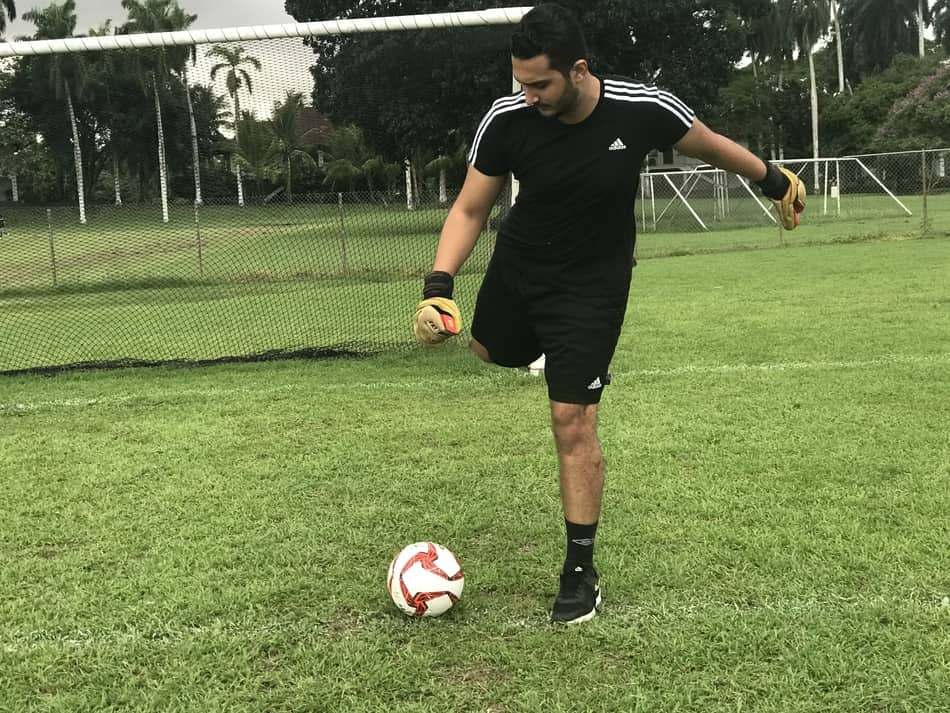
It is very helpful to practice shooting the ball when you’re standing still. This helps your body get use to shooting at uncomfortable situations when your body isn’t 100% prepared to make a shot. This will also help you increase the power of your shot even if you don’t have an appropriate run-up.
Crossing and finishing
This is one of the drills I’ve seen the most being practiced by professional teams. To do the drill you will need at least two players. Have someone running in the wing and making crosses to the box. The player in the box needs to put the ball in the net with only one touch. It can either be with your head, your feet or every single part of your body that isn’t your hands. This is a great exercise to improve first touch finishing and improvisation.
How to get the most out of this drills
Readiness: prepare with purpose. When training, always put quality over quantity. In soccer it’s not about training more, it’s about training better. Also, use smart goals to maintain your purpose and stay in track until you accomplish what you want. Always go one step at a time.
Put yourself in real game situations. Every time you practice these drills, you have to put yourself in real game situations. Train with intensity, just as if you were playing a game. By doing this, you put quality over quantity and, when the real game comes, you’ll be able to execute just as you did at practice. Make sure to create drills that simulate real movements and situations that can happen in a game.
Related Questions
Can defenders score in soccer? Of course they can. Commonly defenders score goals in corner kicks with a header because they are the tallest players in the field. We’ve seen great scoring defenders through the years like Sergio Ramos and Gerard Pique. Defenders should always remember that their most important duty is to defend and not to score goals.
What happens if same points and goal difference? Every tournament will have their unique differentiation factors. If both points and goal difference are tied, the team with the most goals scored from the two will pass. If they are still tied in this aspects, yellow and red cards will determine the winner. If even after this they are still tied, usually the winner will be determined with a coin toss.

